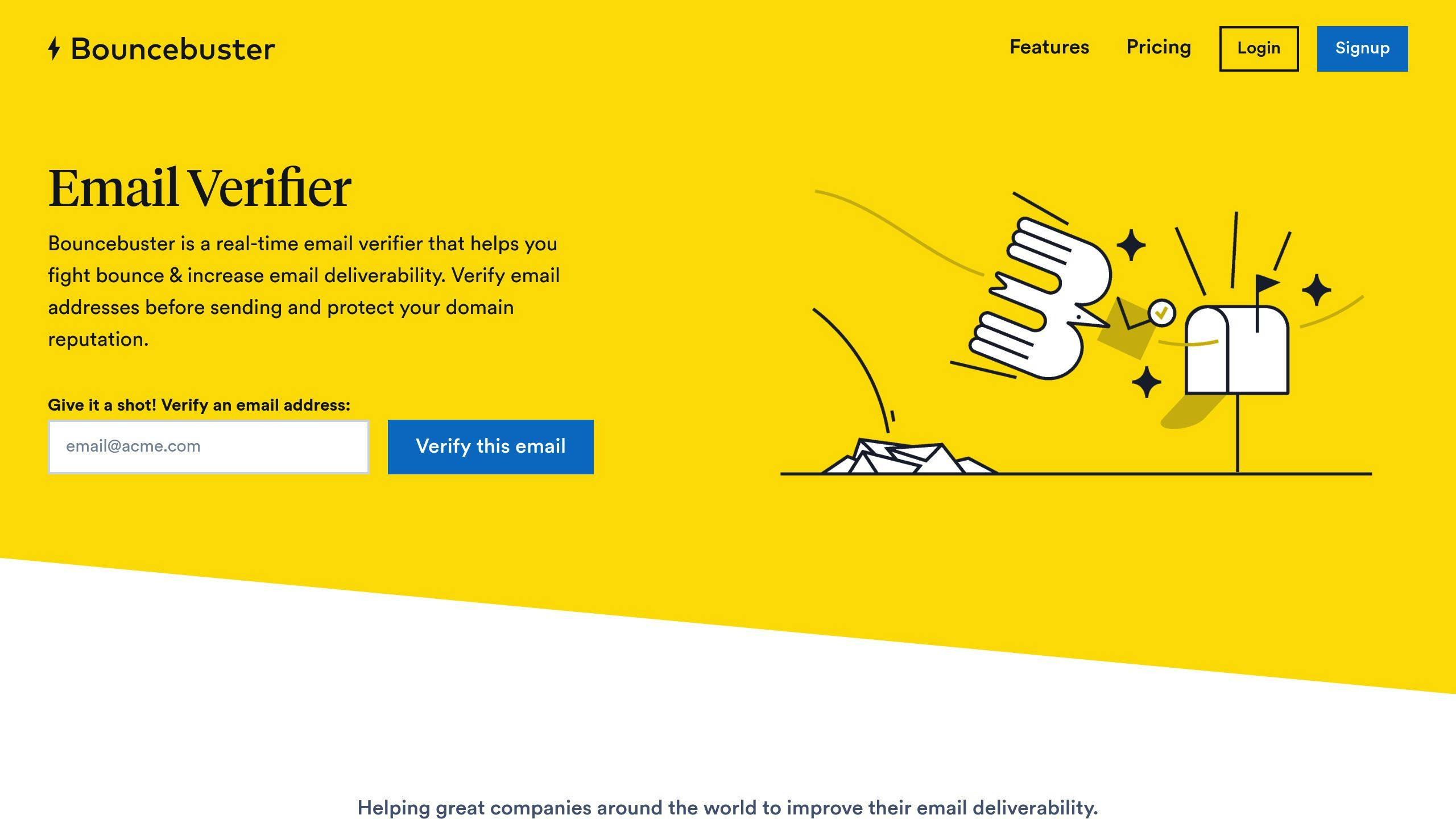Real-time email validation instantly checks email accuracy during signups, purchases, or subscriptions. It ensures correct syntax, valid domains, and active mailboxes in milliseconds, helping e-commerce businesses reduce cart abandonment, improve email deliverability, and prevent fraud. Key benefits include:
- Lower cart abandonment: Recover lost sales by ensuring confirmation emails reach valid inboxes.
- Improved communication: Validated emails achieve up to 98% deliverability, reducing missed messages.
- Fraud prevention: Blocks fake signups and saves costs by detecting disposable or risky email addresses.
For example, outdoor retailer REI reduced cart abandonment by 15%, and Zappos cut hard bounce rates from 8.7% to 0.3% using real-time validation. To implement, choose a service with high accuracy, integrate it with your platform, and track metrics like bounce rates and abandoned carts.
Advantages of Real-Time Email Validation for E-Commerce
Reducing Cart Abandonment
Real-time email validation helps lower cart abandonment by catching invalid email addresses during the checkout process. For example, one company managed to recover $50,000 per month by ensuring confirmation emails reached valid inboxes [2]. This directly impacts revenue and highlights the importance of accurate email data.
Improving Customer Communication
Validated email addresses ensure more dependable communication with customers. Research shows that validated email lists achieve a 98% deliverability rate, compared to just 73% for unvalidated lists [5]. This means fewer missed messages and happier customers, while also cutting down on support costs.
One large online retailer reported a 25% drop in customer service inquiries about missing order confirmations after introducing real-time email validation [3].
Preventing Fake Signups and Fraud
Real-time validation also plays a key role in reducing fraud by systematically verifying email addresses. This adds an extra layer of protection against malicious activities, improving overall data integrity.
Here’s how it makes a difference:
| Fraud Prevention Metrics | Results with Real-Time Validation |
|---|---|
| Fake Account Creation | 40% reduction in three months [6] |
| Cost Savings | $3.60 saved per fraud attempt blocked |
Beyond filtering invalid emails, this technology can detect disposable email addresses and suspicious usage patterns, helping businesses safeguard their platforms and maintain clean, reliable data.
Steps to Implement Real-Time Email Validation
Choosing an Email Validation Service
When picking an email validation service for your e-commerce platform, focus on providers with accuracy rates of 99% or higher and reliable API options. Look for solutions that can scale with your business and offer multiple validation checks, like syntax, domain, and mailbox verification.
| Feature | Priority |
|---|---|
| Real-time API | Critical |
| Bulk processing | High |
| Custom integration | High |
To implement effectively, you’ll need to follow three main steps: selecting the right service, integrating it with your platform, and continuously refining its use.
Integrating with E-Commerce Platforms
Smooth integration is essential to maintain a good user experience. Most platforms, like Shopify or WooCommerce, support either API connections or pre-built plugins to make this process easier.
For example, a Shopify-based fashion retailer managed to cut failed order notifications by 32% after adding real-time email validation [7].
Establishing Email Validation Best Practices
Use progressive validation techniques to provide instant feedback without frustrating users. For example, REI’s case study highlights how this approach can enhance user experience.
Clear error messages are essential. Examples include:
- "Please double-check your email address for typos."
- "This domain seems incorrect – did you mean gmail.com?"
Set rate limits that align with your website’s traffic to avoid performance issues. To measure success, track metrics like:
- Reduction in email bounce rates
- Changes in cart abandonment rates
- Fewer customer support tickets related to email errors
These practices lay the groundwork for exploring advanced technical features in upcoming sections.
Ecommerce fraud prevention with Clearout!
sbb-itb-f42cab2
Key Features of Email Validation Tools
Effective email validation tools rely on three main technical functions:
Real-Time and Bulk Verification
Real-time email validation stops invalid entries during form submissions, improving both user experience and data accuracy.
For example, Zappos cut its hard bounce rates from 8.7% to 0.3% by using real-time validation, which also boosted their email campaign revenue [1][2].
API Integration and Automation
API functionality allows email validation to work seamlessly across different points in your e-commerce platform, enhancing efficiency [6].
| Touchpoint | Advantage |
|---|---|
| Account Creation | Blocks fake signups |
| Checkout Process | Reduces failed order alerts |
| Newsletter Signup | Improves email list accuracy |
| Customer Support | Ensures consistent communication |
Integration with Marketing Tools
Look for tools that connect easily with:
- Email marketing platforms
- CRM systems
- E-commerce platforms
- Marketing automation tools
Such integrations, available in services like Bouncebuster, are especially useful for businesses aiming to grow their marketing efforts [4].
Focus on Bouncebuster

Bouncebuster is designed for e-commerce businesses looking to tackle checkout and fraud challenges head-on with real-time validation tools.
Bouncebuster’s Key Features
Bouncebuster offers a mix of real-time API validation and bulk cleaning tools, including:
- Bulk email list cleaning with over 99% accuracy
- Manual verification tools for checking individual emails
- High-risk domain detection to identify potential threats
How Bouncebuster Supports E-Commerce
Bouncebuster targets common e-commerce issues with its validation system:
| Challenge | Solution | Result |
|---|---|---|
| Cart abandonment | Instant checkout validation | 5% increase in completions |
| High bounce rates | Algorithmic email verification | 98% fewer bounces |
| Fraud prevention | Domain risk scoring | 40% drop in fake accounts |
It integrates seamlessly with platforms like Shopify, WooCommerce, and Magento (expected in Q2 2025), making setup straightforward.
Bouncebuster’s Plan Options
| Tier | Volume | Key Features |
|---|---|---|
| Basic | 10k emails/mo | Core API + bulk cleaning |
| Pro | 100k emails/mo | Priority support |
| Enterprise | Unlimited | Custom workflows and features |
The Basic plan is ideal for startups managing fewer than 1,000 orders per month. The Pro plan suits mid-sized businesses processing 10,000+ orders monthly. For larger operations, the Enterprise plan provides tailored integrations and dedicated support.
Bouncebuster also offers integration guides tailored to popular e-commerce platforms, along with detailed documentation and a robust knowledge base for smooth onboarding.
Conclusion and Action Steps
Key Takeaways
Real-time email validation is a practical way to tackle cart abandonment and fraud issues. For example, cart abandonment emails boast a 45% open rate, with 11% converting into recovered sales [8]. These stats align with earlier case studies, showing its impact on various business metrics.
Aside from recovering lost sales, email validation plays a crucial role in maintaining clean data and shielding your business from fraud. Businesses that adopt real-time validation often see noticeable improvements in their key performance metrics.
How to Get Started with Email Validation
If you’re ready to incorporate email validation into your process, focus on these areas:
What to Look for in a Service:
- High accuracy rates (at least 98%)
- Real-time API functionality
- Compatibility with your e-commerce platform
- Fraud detection tools
- Responsive customer support
Steps to Implement:
- Review your current email bounce rates and checkout issues
- Add validation to all customer interaction points
- Adjust validation settings based on your fraud trends
- Conduct thorough testing before going live
- Train your customer service team on the system
- Regularly track and fine-tune performance
FAQs
What is the API for verifying email?
An email verification API checks email addresses instantly during processes like checkout or account creation. It provides a quick assessment of deliverability, email type, and potential errors. This can directly impact metrics like cart abandonment, as discussed earlier.
Here’s how it works across key touchpoints:
| Touchpoint | Validation Purpose | Business Impact |
|---|---|---|
| Account Creation | Block fake signups | Cut fraud rates by up to 98% |
| Checkout Process | Identify typos or errors | Lower cart abandonment rates |
| Newsletter Signup | Verify valid addresses | Boost marketing campaign ROI |
For teams planning to implement this, keep these API essentials in mind:
- HTTPS encryption: Ensures data stays secure.
- Error handling: Maintains a smooth user experience.
- Cached validations: Speeds up response times.
- Usage monitoring: Helps fine-tune performance.
These features are crucial for reducing fraud and recovering abandoned carts, as highlighted earlier.
"Bouncebuster’s 2024 case studies show real-time validation can lead to a significant reduction in bounced emails, with businesses reporting up to 98% accuracy in email validation. This translates to improved deliverability and better customer communication."
Platforms like Bouncebuster provide REST API solutions to make integration seamless.



